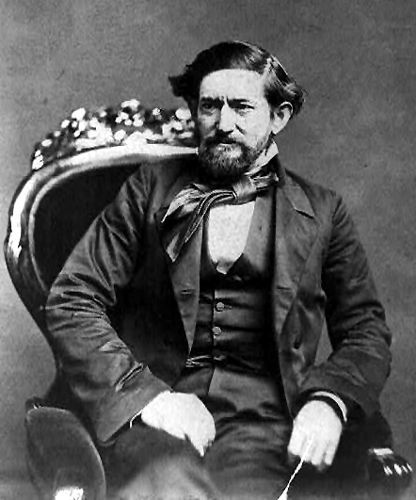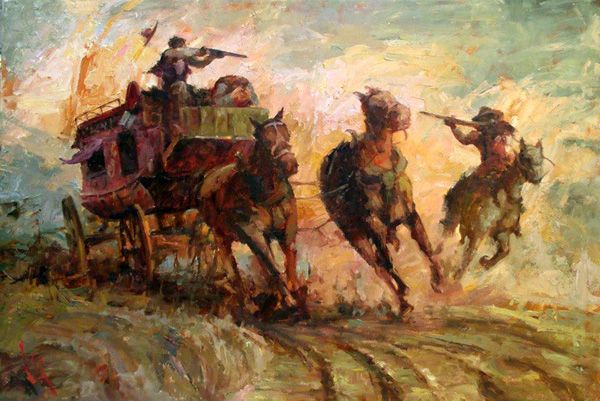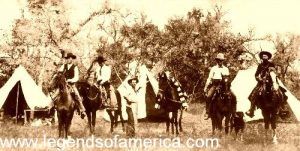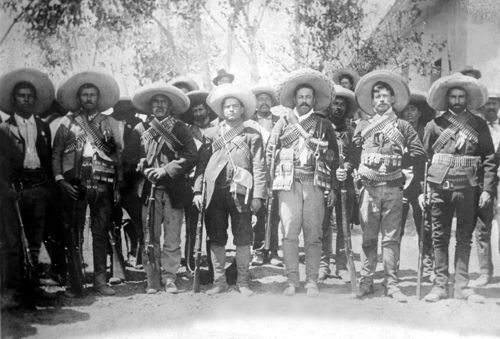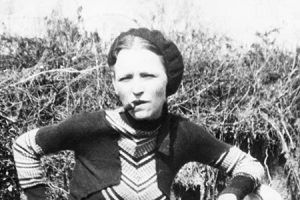When at the age of sixteen, I joined a merry band.
We marched from San Antonio down to the Rio Grande.
Our captain he informed us perhaps he thought it right,
“Before we reach the station, we’ll surely have to fight.”
The second oldest state-level law enforcement agency in the United States, the Texas Rangers, started in 1823, only two years after white settlement in Texas formally began. Following the Mexican War of Independence, some 600 to 700 families moved to Texas; however, it had no regular army to protect its new citizens. New Empresario Stephen F. Austin soon began to organize experienced frontiersmen as “rangers” in informal groups to protect the settlers against Indian attacks and other criminal elements.
It was not until October 17, 1835, that Texas formally constituted the force that has since been known as the Texas Rangers. On November 24, 1835, Robert McAlpin Williamson was chosen as the first Ranger Major.
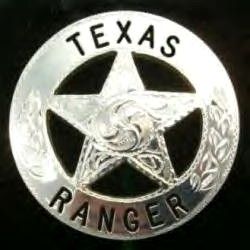
Beginning with a complement of 56 men in three companies, the Rangers grew quickly as their numbers increased to more than 300 by 1837. Though officially sanctioned and their numbers increased, the Rangers served sparingly in their first few years.
During Texas’ fight for independence from Mexico, the Rangers sometimes served as scouts and couriers. Other menial tasks were also assigned to them, such as retrieving cattle, escorting refugees, and destroying supplies and equipment left behind by the Mexicans.
Once independence was gained and the land became the Republic of Texas, the lawmen continued to see very little duty under President Sam Houston. However, when Mirabeau B. Lamar became President in 1838, he rejected Houston’s frontier policies of friendship with the Indians and engaged the Rangers in a war against the tribes. The Texas Congress allowed him to recruit eight companies of mounted volunteers and maintain a company of 56 Rangers. He provided for five similar companies in Central and South Texas a month later.
Over the next three years, the Rangers waged an all-out war against the Indians, successfully participating in several battles, including the Council House Fight in San Antonio, the raid on Linnvile, and the Battle of Plum Creek. By the time Lamar’s administration was over, Texans had severely damaged the strength of the most powerful tribes.
When Sam Houston was reelected to the presidency in December 1841, he saw the effectiveness of the Rangers. On January 29, 1842, he approved a law that officially provided for a company of mounted men to “act as Rangers.” As a result, 150 Rangers, under Captain John Coffee “Jack” Hays, were assigned to protect the southern and western portions of the Texas frontier. Houston’s foresight in this decision proved successful in helping to repel the Mexican invasions of 1842 and shielding the white settlers against Indian attacks over the next three years.
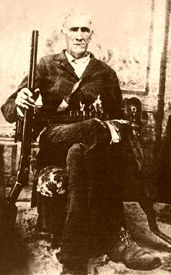
Bigfoot Wallace
Hays was also responsible for improving the quality of recruitments, initiating tough training programs for the new Rangers, and initiating an “esprit de corps” within his command. From this group came several celebrated ranger captains, including W. A. A. “Big Foot” Wallace, Ben and Henry McCulloch, Samuel H. Walker, and Robert Addison “Ad” Gillespie.
Texas officially became part of the United States in 1846, which also started the Mexican-American War when the U.S. attempted to establish the boundary at the Rio Grande. During the two-year affair, the Texas Rangers were called on to assist the American Army and soon achieved worldwide fame as a fighting force. Superbly mounted with a large assortment of weapons, the Rangers were found to be so successful against Mexican guerillas that they soon earned the name “los diablos Tejanos” or the “Texas Devils.”
When the Mexican-American War ended on February 2, 1848, the United States assumed responsibility for protecting the Texas frontier. Having no official function, the Rangers soon lost several of its famous captains and frontier defenders. A decade later, in the Spring of 1858, they briefly saw combat again when they were sent north to the Red River to settle a band of Comanche Indians.
After Texas seceded from the United States during the Civil War in 1861, an organization called Terry’s Texas Rangers was created in Houston. Under the leadership of Colonel Benjamin Franklin Terry, many of the former Rangers enlisted under his command.
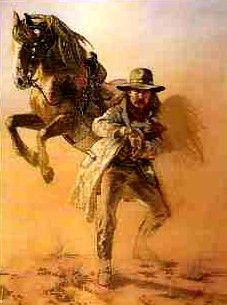
Painting of a Texas Ranger by Hermon Adams
During the reconstruction period of 1865-1873, the Rangers were designated state police. During a dark period in their history, they were charged with enforcing unpopular new laws that came with rejoining the United States. Among the war-weary Texans, the Rangers fell into disrepute. During this period, the Rangers acted as a military-type police unit when enforcing the new laws or fighting Indians or Mexicans. However, when hunting down outlaws, they functioned more as lawmen and posses.
Their role changed again in May 1874, when the state Democrats returned to power and Governor Richard Coke and the Legislature appropriated $75,000 to organize six companies of 75 Rangers each. By this time, Texas was overrun with outlaws, Indians ravaging the western frontier, and Mexican bandits pillaging and murdering along the Rio Grande. The new troops were stationed strategically over the state and were known as the Frontier Battalion. During this era, the Ranger Service held a place between an army and a police force.
In 1877, the Texas Rangers found themselves on the outlaw trail, pursuing John Wesley Hardin. Hardin, who had killed Charles Webb, a deputy sheriff in Brown County, in 1874, left the state when he began to be relentlessly pursued. However, one Texas Ranger named John Barclay Armstrong, better known as “McNelly’s Bulldog,” received permission to pursue Hardin across state lines. Finally catching up with the notorious outlaw on a train in Pensacola, Florida, the inevitable shoot-out occurred. When the smoke cleared, Hardin had been knocked unconscious, one of his gang members killed, and the rest were arrested on July 23, 1877.
In the spring of 1878, Sam Bass and his gang held up two stagecoaches and four trains within 25 miles of Dallas. The gang quickly found themselves the target of a spirited chase across North Texas by a special company of Texas Rangers headed by Junius Peak. Bass eluded his pursuers until one of his party, Jim Murphy, turned informer. As the Bass Gang rode south intending to rob a small bank in Round Rock, Murphy wrote to Major John B. Jones, commander of the Frontier Battalion of Texas Rangers.
In Round Rock, Texas, where Jones set up an ambush, a fierce battle between the gang and the Rangers occurred on July 19, 1878. In the melee, Bass’ sidekick, Seaborn Barnes, was killed, and Sam was wounded, though he was able to ride away on his horse. The next morning he was found lying helpless in a pasture north of town and was brought back to Round Rock, where he died on July 21.
Over the next several years, the Frontier Battalion captured more than 3,000 Texas outlaws, but by 1882 the “frontier” was beginning to disappear.
During the next three decades, the Rangers’ prominence and prestige waned. However, they continued to occasionally intercept cattle rustlers, contended with Mexican and Indian marauders along the Rio Grande, and sometimes protected blacks from white lynch mobs. By the turn of the century, critics began to urge the curtailment or abandonment of the Texas Rangers. As a result, the Frontier Battalion was abolished in 1901, and the Ranger force was cut to four law enforcement companies of twenty men each.
Ranger activities were soon redirected towards law enforcement among Texas citizens, but when violence increased along the Rio Grande, the Rangers participated in numerous bloody brush fights with Mexican nationals.
In 1914, during the early days of World War I, the Rangers had the daunting task of identifying and rounding up numerous spies, conspirators, saboteurs, and draft dodgers. In 1916, Pancho Villa’s raid on Columbus, New Mexico, intensified harsh feelings between the United States and Mexico. As a result, the regular Rangers and hundreds of special Rangers appointed by Texas governors killed approximately 5,000 Hispanics between 1914 and 1919, which soon became a source of scandal and embarrassment.
To restore public confidence, the Texas legislature overhauled the force in January 1919, but not before several sordid tales of ranger brutality emerged. Soon the four companies of Ranger recruits were cut from 20 to 15 per unit. The legislature also established higher salaries to attract men of higher character and established procedures for citizen complaints.
After the enactment of Prohibition in 1920, the Ranger’s primary function was patrolling the Rio Grande against tequila smugglers and cattle rustlers.
During the Great Depression, the Ranger force was reduced to 45 men. Adding fuel to the fire, the Rangers openly supported Governor Ross Sterling against Miriam A. “Ma” Ferguson in the Democratic primary in the fall of 1932. As a result, when Ferguson took office in January 1933, she fired every Ranger for his partisanship, slashed salaries, and the budget further reduced the force to 32 men. Without the protection of the Rangers, Texas soon became a haven for outlaws such as Raymond Hamilton, George “Machine Gun” Kelly, Clyde Barrow, and Bonnie Parker.
In 1934, Frank A. Hamer, a long-time Ranger who resigned during Ferguson’s cutback, was asked by the head of the Texas prison system to utilize his skills to track down Bonnie and Clyde. Previously the pair had successfully broken out a gang member from the Huntsville Prison, killing a guard.
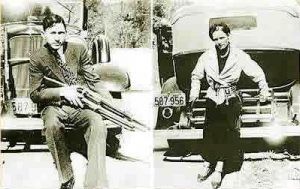
Bonnie and Clyde
After tracking the Barrow gang across nine states, Frank Hamer and law enforcement in Louisiana learned that Bonnie and Clyde had visited Bienville Parish on May 21, 1934, and that Clyde had designated a rendezvous point near there with gang member Henry Methvin. Unknown to Bonnie and Clyde was that Methvin, cooperating with law enforcement, participated in assisting with an ambush along the route to the rendezvous.
A posse, led by former Texas Rangers Hamer and Manny Gault, including two Louisiana lawmen and two more Texans, lie in wait on Highway 154 between Gibsland and Sailes. In place by 9:00 p.m., they waited all night and through the next day with no sign of Bonnie and Clyde. However, around 9:10 a.m. on May 23, 1934, the posse, concealed in the bushes and almost ready to concede defeat, heard Clyde’s stolen Ford V-8 approaching. When he stopped to speak with Henry Methvin’s father, planted there with his truck that morning to distract Clyde and force him into the lane closest to the posse, the lawmen opened fire, killing Bonnie and Clyde while shooting a combined total of approximately 130 rounds.
It is unclear what legal authority was to kill Bonnie Parker, who was not known to have killed anyone, but Hamer clarified that he had intended to kill her. He had a reputation for not being overly concerned about law details. Hamer and others from the posse kept for themselves some of the stolen guns from Bonnie and Clyde’s vehicle, and the United States Congress awarded him a special citation for trapping and killing the outlaws.
In 1935, James Allred became the Texas governor after running on a better law enforcement platform. The legislature soon established the Texas Department of Public Safety, which the Texas Rangers became a part of on August 10, 1935. Also in this new department was the Highway Patrol and a scientific crime laboratory and detection center known as the Headquarters Division.
Over the years, the Texas Rangers have investigated crimes ranging from murder to political corruption, kept the peace during riots, protected the Texas governor, tracked down fugitives, and functioned as a quasi-military force.
Today’s Texas Rangers are an investigative division of the Texas Department of Public Safety. The more than 100 highly trained men and women are posted across the State of Texas and are one of the world’s most effective investigative law enforcement agencies.
© Kathy Alexander/Legends of America, updated March 2023.
More Information:
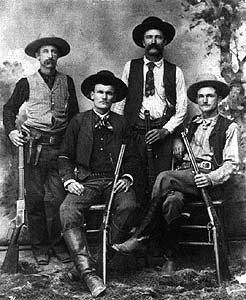
Texas Rangers, 1890
Texas Ranger Hall of Fame
I-35 and University Parks Drive
PO Box 2570
Waco, Texas
76702-2570
Also See:
Sources: See Credits & Resources


